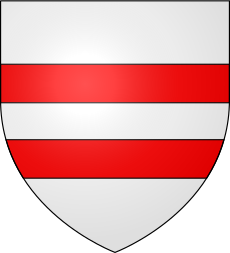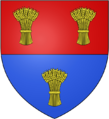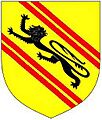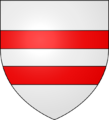Feudal barony of Barnstaple facts for kids
The feudal barony of Barnstaple was a large area of land in Devon, England, controlled by a powerful lord. It was like a mini-kingdom within the larger kingdom, with its main headquarters (called a caput) in the town of Barnstaple. This barony was one of eight similar areas in Devon during the Middle Ages. By 1236, it included 56 "knight's fees," which meant the lord of Barnstaple had to provide 56 knights or soldiers to the king's army. Later, this service could be changed to a payment called "scutage."
Contents
Who Owned the Barony?
The de Mowbray Family
The first person to be granted the barony of Barnstaple was Geoffrey de Mowbray, the Bishop of Coutances. This happened after William the Conqueror took over England in 1066. Geoffrey is listed as the owner in the famous Domesday Book from 1086.
When Geoffrey died, his nephew Robert de Mowbray took over. Robert was also the Earl of Northumberland. However, in 1095, Robert rebelled against King William II. Because of this, his lands, including the Barnstaple barony, were taken back by the king. This was called "escheating to the crown."
The de Totnes Family
Before he died in 1100, King William II gave the barony of Barnstaple to Juhel de Totnes. Juhel was from Brittany and had previously been a feudal baron of Totnes. The king had taken his lands in Totnes away after William the Conqueror died.
Around 1107, Juhel started Barnstaple Priory, which was a type of monastery. Juhel's son, Alfred de Totnes, died without any children. This meant the barony was split between his two sisters, who became co-heiresses. Each sister inherited half, or a "moiety," of the barony.
The de Braose and de Tracy Families
Because the barony was split between two sisters, it was owned in two halves for many years, from about 1139 to 1213. Eventually, the de Tracy family brought both halves back together.
Here's how the two halves were passed down:
- One sister, Aenor de Totnes, married Philip de Braose. Their half of the barony went to their son, William de Braose, 3rd Lord of Bramber, and then to his son, William de Braose, 4th Lord of Bramber (who died in 1211). In 1208, King John took William de Braose's lands. In 1213, King John gave this half of the barony to Henry de Tracy, who had married William de Braose's granddaughter, Matilda.
- The other de Totnes sister (whose name we don't know) married Henry de Tracy. Their son, Oliver de Tracy, inherited her half. Later, his son, also named Oliver, inherited it. This second Oliver's heir was Henry de Tracy (who died in 1274). This is the same Henry de Tracy who received the other half of the barony in 1213. So, Henry de Tracy now owned the entire barony!
Henry de Tracy had married Matilda de Braose. She was given the manor of Tawstock, a large estate near Barnstaple, by her aunt. From then on, Henry de Tracy made Tawstock his main home.
When Henry de Tracy died, the barony went to his granddaughter, Maud de Brian.
The FitzMartin Family
Maud de Brian first married Nicholas FitzMartin. After Nicholas died, Maud married Geoffrey de Camville. Geoffrey was an important lord and was called to Parliament. He kept control of the barony even after Maud died, which was allowed by a rule called "the curtesy of England."
After Geoffrey de Camville died, the barony went to Maud's son, William Martin, 1st Baron Martin (who died in 1324). However, William's son, William FitzMartin, died without children in 1326.
The Audley Family
Since William FitzMartin had no children, the barony was inherited by his sisters. One sister, Eleanor Martin, died without children. The other sister, Joan Martin, had a son named James Audley, 2nd Baron Audley. In 1342, James Audley inherited the entire barony of Barnstaple.
When James Audley died in 1386, the barony went to his son, Nicholas Audley, 3rd Baron Audley. But Nicholas also died without children. So, the barony was split again among his sisters and their families:
- Joan Audley (1331–1393) married Sir John Tuchet.
- Margaret Audley (died 1411) married Sir Roger Hillary.
- Margaret Audley (died 1373) married Fulk FitzWarin. Her grandson, Fulk FitzWarin, inherited the manor of Tawstock. Tawstock became the main home for the later owners of the barony, the Bourchier family, who were Earls of Bath. They also inherited other important estates that were part of the Barnstaple barony.
The King Takes Over
Before he died, James Audley (who died in 1386) had arranged for the barony of Barnstaple to go to his male heirs. If he had no male heirs, it would go to the king. Since all his sons died without male children, the barony became the property of King Richard II (1377–1399).
King Richard II first gave the barony to Robert de Vere, Duke of Ireland. However, Robert de Vere was later found guilty of treason in 1388, and the barony went back to the king.
Then, King Richard II gave it to his half-brother, John Holland, 1st Duke of Exeter. John Holland was loyal to Richard II. But when Henry Bolingbroke (who became King Henry IV) took the throne from Richard II in 1399, John Holland rebelled and was executed in 1400. The barony then passed to his eldest son, Richard Holland, who also died that same year.
From 1425, the barony was held by John Holland, 2nd Duke of Exeter, the first Duke's son. When he died in 1447, it went to his son, Henry Holland, 3rd Duke of Exeter. Henry was found guilty of treason in 1461, and his lands were given to his wife, Anne of York, Duchess of Exeter. Anne was the sister of Kings Edward IV and Richard III.
After Anne died, her second husband, Thomas St. Leger, held the lands until he was executed in 1483. In 1483, King Richard III gave the "Castle and Borough of Barnstaple" to Thomas Everingham. But King Henry VII took the throne in 1485 and later gave it to his mother, Margaret Beaufort.
Queen Mary I
Queen Mary (1553–1558) granted the barony to Thomas Marrow. However, by this time, the barony had lost most of its power and lands. It was a "feudal barony" in name only, meaning it didn't come with many lands or tenants (people who rented land) anymore. It also didn't give the owner a right to sit in Parliament.
The Castle Manor
Soon after, a man named Sir John Chichester bought this "castle-manor" from Samuel Marowe. Sir John Chichester lived nearby in Raleigh. He rented out parts of the old castle area, like orchards and houses, to people in Barnstaple.
In 1566, Sir John Chichester gave up his rights to the Manor of Barnstaple to the Mayor and leaders of the town. As part of this deal, the town had to provide him with two "fish dinners" every year! Later, his family agreed to stop the fish dinners if the town paid two yearly payments to charities in Barnstaple instead.
The old "Manor of Hogsfee" was also connected to the castle manor. In the 1730s, the Mayor and Aldermen of Barnstaple bought this manor.
Images for kids













